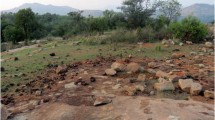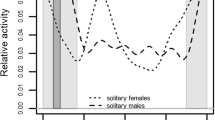Abstract
Lizards often respond to predators by hiding in sunless refuges, but this eliminates opportunities for thermoregulatory basking. Hiding can therefore lower body condition. Furthermore, in ectotherms basking is important to induce fever and activate an immune response. A potential trade-off therefore exists between lowering predation risk and elevating body temperature to fight infection. Such a trade-off could be habitat dependent if habitats differ in the relative risk of predation versus that of acquiring or countering an infection. Here we take an experimental approach to test whether lizard basking behavior is affected by a trade-off between predator avoidance and fighting an infection. We quantified the anti-predator behavior of male lizards (Podarcis liolepis) both before and after they were immune challenged (injected with LPS) or not (injected with PBS control). To test the generality of any trade-off, we tested lizards from both an urban and a natural habitat. We found that males spent less time hiding following a simulated predator attack after they had been immune challenged than before, but this decline was only significant for males from the natural habitat. We also tested whether morphological traits, body condition, and immune response level explained variation in male hiding time. In the natural habitat, but not in the urban habitat, males with relatively small heads hid for significantly longer. In conclusion, we show that lizard anti-predator behavior is affected by an immune challenge. Habitat differences in the factors that predict hiding time offers potential insights into why this might be the case.
Significance statement
There is a potential trade-off for ectotherms between remaining in a place protected from predators and countering an immune challenge. This is because hiding in sunless refuges eliminates opportunities for thermoregulatory basking that induce a fever. The optimal response to this trade-off might change depending on the habitat. Here, we compare the hiding behavior of males from natural and urban habitat following an experimental immune challenge. We found that the hiding time of immune-challenged males decreased but only for those from the natural habitat.


Similar content being viewed by others
References
Aierbe T, Olano M, Vázquez J (2001) Atlas of nesting birds in Gipuzkoa. Munibe Ciencias Naturales 52:5–138
Amo L, López P, Martín J (2006) Nature-based tourism as a form of predation risk affects body condition and health state of Podarcis muralis lizards. Biol Conserv 131:402–409
Anderson RA, Vitt LJ (1990) Sexual selection versus alternative causes of sexual dimorphism in teiid lizards. Oecologia 84:145–157
Aubert A (1999) Sickness and behaviour in animals: a motivational perspective. Neurosci Biobehav Rev 23:1029–1036
Bates D, Maechler M, Bolker B, Walker S (2015) Fitting linear mixed-effects models using lme4. J Stat Softw 67:1–48
Braña F (1996) Sexual dimorphism in lacertid lizards: male head increase vs. female abdomen increase? Oikos 75:511–523
Cabido C, Gonzalo A, López P, Martín J (2008) Poblaciones urbanas de la lagartija ibérica: uso Como bioindicador de los efectos del ambiente urbano. Caja de Ahorros y Monte de Piedad de Segovia, Segovia
Cabido C, Galán P, López P, Martín J (2009) Conspicuousness-dependent antipredatory behavior may counteract coloration differences in Iberian rock lizards. Behav Ecol 20:362–370
Carrillo M (1979) El Castillo de Santa Cruz de la Mota y las murallas de San Sebastián. Grupo Dr. Camino de Historia Donostiarra, Donostia/San Sebastián
Contesse P, Hegglin D, Gloor S, Bontadina F, Deplazes P (2004) The diet of urban foxes (Vulpes vulpes) and the availability of anthropogenic food in the city of Zurich, Switzerland. Mamm Biol 69:81–95
Cooper WE Jr (1997) Threat factors affecting antipredator behavior in the broad-headed skink (Eumeces laticeps): repeated approach, change in predator path, and predator’s field of view. Copeia 1997:613–619
Cooper WE Jr (1999) Tradeoffs between courtship, fighting, and antipredatory behavior by a lizard, Eumeces laticeps. Behav Ecol Sociobiol 47:54–59
Cooper WE Jr (2000) Tradeoffs between predation risk and feeding in a lizard, the broad-headed skink (Eumeces laticeps). Behaviour 137:1175–1189
Cooper WE Jr, Blumstein DT (2015) Escaping from predators. An integrative view of escape decisions. Cambridge University Press, Cambridge
Cooper WE Jr, Wilson DS (2007) Sex and social costs of escaping in the striped plateau lizard Sceloporus virgatus. Behav Ecol 4:764–768
Cooper WE Jr, Pérez-Mellado V, Hawlena D (2007) Number, speeds, and approach paths of predators affect escape behavior by the Balearic lizard, Podarcis Lilfordi. J Herpetol 41:197–204
R Core Team (2015) R: A language and environment for statistical computing. R Foundation for Statistical Computing, Vienna, Austria, http://www.R-project.org/
Deen CM, Hutchison VH (2001) Effects of lipopolysaccharide and acclimation temperature on induced behavioral fever in juvenile Iguana iguana. J Therm Biol 26:55–63
Deutsch CA, Tewksbury JJ, Huey RB, Sheldon KS, Ghalambor CK, Haak DC, Martin PR (2008) Impacts of climate warming on terrestrial ectotherms across latitude. P Natl Acad Sci USA 105:6668–6672
Díaz-Uriarte R (1999) Anti-predator behaviour changes following an aggressive encounter in the lizard Tropidurus hispidus. Proc R Soc Lond B 266:2457–2464
Ditchkoff SS, Saalfeld ST, Gibson CJ (2006) Animal behaviour in urban ecosystems: modifications due to human-induced stress. Urban Ecosyst 9:5–12
do JPS A, GA M, VH H (2002) The influence of bacterial lipopolysaccharide on the thermoregulation of the box turtle Terrapene carolina. Phys Biochem Zool 75:273–282
French SS, Johnston GIH, MC M (2007a) Immune activity suppresses reproduction in food-limited female tree lizards Urosaurus ornatus. Funct Ecol 21:1115–1122
French SS, DeNardo DF, Moore MC (2007b) Trade-offs between the reproductive and immune systems: facultative responses to resources or obligate responses to reproduction? Am Nat 170:79–89
Garrido M, Pérez-Mellado V (2015) Human pressure, parasitism and body condition in an insular population of a Mediterranean lizard. Eur J Wildlife Res 61:617–621
Gering JC, Blair B (1999) Predation on artificial birds’ nests along an urban gradient: predatory risk or relaxation in urban environments. Ecography 22:532–541
Green AJ (2001) Mass/length residuals: measures of body condition or generation of spurious results? Ecology 82:1473–1483
Harrison XA (2014) Using observation-level random effects to model overdispersion in count data in ecology and evolution. PeerJ 2:e616
Janeway CA, Travers P, Walport M, Shlomchik M (2001) Immunobiology. The immune system in health and disease. Garland Publishing, New York
Kokko H, Rankin DJ (2006) Lonely hearts or sex in the city? Density-dependent effects in mating systems. Proc R Soc Lond B 361:319–334
Lima SL, Dill LM (1990) Behavioral decisions made under the risk of predation: a review and prospectus. Can J Zool 68:619–640
Llewellyn D, Brown GP, Thompson MB, Shine R (2011) Behavioral responses to immune-system activation in an anuran (the cane toad, Bufo marinus): field and laboratory studies. Phys Biochem Zool 84:77–86
Lochmiller RL, Vestey MR, Boren JC (1993) Relationship between protein nutritional status and immunocompetence in northern bobwhite chicks. Auk 110:503–510
López P, Muñoz A, Martín J (2002) Symmetry, male dominance and female mate preferences in the Iberian rock lizard, Lacerta monticola. Behav Ecol Sociobiol 52:342–347
López P, Martín J, Cuadrado M (2004) The role of lateral blue spots in intrasexual relationships between male Iberian rock-lizards, Lacerta monticola. Ethology 110:543–561
López P, Gabirot M, Martín J (2009a) Immune challenge affects sexual coloration of male Iberian wall lizards. J Exp Zool 311A:96–104
López P, Gabirot M, Martín J (2009b) Immune activation affects chemical sexual ornaments of male Iberian wall lizards. Naturwissenschaften 96:65–69
Martín J, López P (1999a) An experimental test of the costs of antipredatory refuge use in the wall lizard, Podarcis muralis. Oikos 84:499–505
Martín J, López P (1999b) When to come out from a refuge: risk-sensitive and state-dependent decisions in an alpine lizard. Behav Ecol 10:487–492
Martín J, López P (2000) Costs of refuge use affect escape decisions of Iberian rock lizards Lacerta monticola. Ethology 106:483–492
Martín J, López P (2003) Ontogenetic variation in antipredatory behavior of Iberian-rock lizards (Lacerta monticola): effects of body-size-dependent thermal-exchange rates and costs of refuge use. Can J Zool 81:1131–1137
Marzluff JM (2005) Island biogeography for an urbanizing world: how extinction and colonization may determine biological diversity in human-dominated landscapes. Urban Ecosyst 8:157–177
McGlothlin JW, Jawor JM, Ketterson ED (2007) Natural variation in a testosterone-mediated trade-off between mating effort and parental effort. Am Nat 170:864–875
Miranda AC, Schielzeth H, Sonntag T, Partecke J (2013) Urbanization and its effects on personality traits: a result of microevolution or phenotypic plasticity? Glob Change Biol 19:2634–2644
Møller AP (2009) Successful city dwellers: a comparative study of the ecological characteristics of urban birds in the Western Paleartic. Oecologia 159:849–858
Møller AP (2010) The fitness benefit of association with humans: elevated success of birds breeding indoors. Behav Ecol 21:913–918
Otti O, Gantenbein-Ritter I, Jacot A, Brinkhof MWG (2012) Immune response increases predation risk. Evolution 66:732–739
Polo V, López P, Martín J (2005) Balancing the thermal costs and benefits of refuge use to cope with persistent attacks from predators: a model and an experiment with an alpine lizard. Evol Ecol Res 7:23–35
Rigby MC, Jokela J (2000) Predator avoidance and immune defence: costs and trade-offs in snails. Proc R Soc Lond B 267:171–176
Ríos-Chelén AA, Quirós-Guerrero E, Gil D, Macías-García C (2013) Dealing with urban noise: vermilion flycatchers sing longer songs in noisier territories. Behav Ecol Sociobiol 67:145–152
Runemark A, Sagonas K, Svensson EI (2015) Ecological explanations to island gigantism: dietary niche divergence, predation, and size in an endemic lizard. Ecology 96:2077–2092
Samia DSM, Nakawaga S, Nomura F, Rangel TF, Blumstein DT (2015) Increased tolerance to humans among disturbed wildlife. Nat Comm 6:8877
Sih A (1992) Prey uncertainty and the balance of anti-predator and feeding needs. Am Nat 139:1052–1069
Sih A (1997) To hide or not to hide? Refuge use in a fluctuating environment. Trends Ecol Evol 12:375–376
Smits JE, Bortolotti GR, Tella JL (1999) Simplifying the phytohaemagglutinin skin-testing technique in studies of avian immunocompetence. Funct Ecol 13:567–572
Sorace A (2002) High density of bird and pest species in urban habitats and the role of predator abundance. Ornis Fennica 79:60–71
Stevenson RD, Peterson CR, Tsuji JS (1985) The thermal dependence of locomotion, tongue flicking, digestion, and oxygen consumption in the wandering garter snake. Phys Zool 58:46–57
Svensson E, Sinervo B, Comendant T (2001) Density dependent competition and selection on immune function in genetic lizard morphs. P Natl Acad Sci USA 98:12561–12565
Uller T, Isaksson C, Olsson M (2006) Immune challenge reduces reproductive output and growth in a lizard. Funct Ecol 20:873–879
Wood JLA, Grant JWA, Belanger MH (2012) Population density and territory size in juvenile rainbow trout Oncorhynchus mykiss: implications for population regulation. Can J Fish Aquat Sci 69:1121–1128
Ydenberg RC, Dill LM (1986) The economics of fleeing from predators. Adv Stud Behav 16:229–249
Yeh PJ (2004) Rapid evolution of a sexually selected trait following population establishment in a novel habitat. Evolution 58:166–174
Acknowledgments
We thank Michael Jennions and two reviewers for their invaluable help improving the manuscript, Ion Garin-Barrio for field assistance, José Martín for helpful comments, and Aranzadi Society of Sciences for use of their facilities. The study was performed under license from the Gipuzkoa Administration. This work was supported by Basque Government (Saitotek program), Donostia city council, and the Spanish Ministry of Education and Culture with a pre-doctoral grant to M. I-C (grant number FPU12/04148).
Author information
Authors and Affiliations
Corresponding author
Ethics declarations
Conflict of interest
The authors declare that they have no conflict of interest.
Ethical approval
All capture and handling of lizards complied with the contemporary laws regulating the treatment of animals in Spain and was performed under license from the Bizkaia and Gipuzkoa Administrations (numbers 1695 and 2222).
Informed consent
Not applicable
Additional information
Communicated by S. J. Downes
Rights and permissions
About this article
Cite this article
Iglesias-Carrasco, M., Head, M.L. & Cabido, C. Habitat dependent effects of experimental immune challenge on lizard anti-predator responses. Behav Ecol Sociobiol 70, 1931–1939 (2016). https://doi.org/10.1007/s00265-016-2199-7
Received:
Revised:
Accepted:
Published:
Issue Date:
DOI: https://doi.org/10.1007/s00265-016-2199-7




